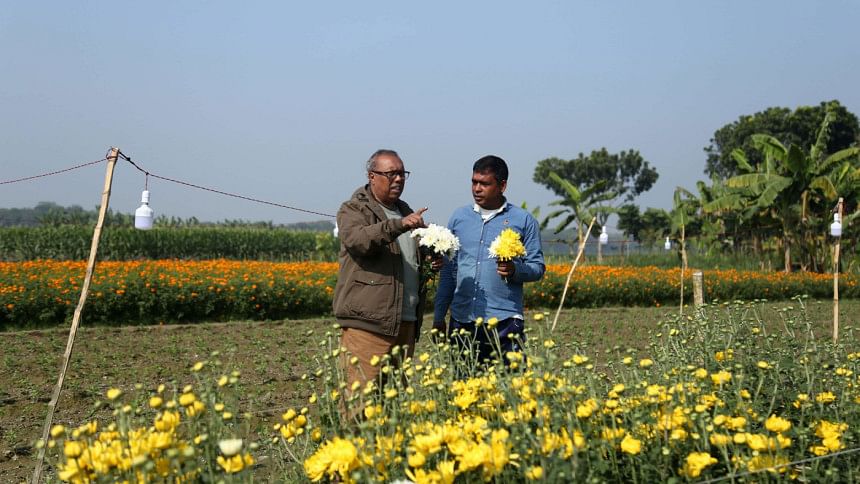LED lights revolutionize chrysanthemum cultivation

Flower business was expanding in Bangladesh with immense potential. Flowers were becoming more occasional and ornamental product nowadays. We can't just call it a luxury item now while farmers also saw the benefits of flowers cultivation. But amid the COVID-19 outbreak, a vivid shock has altered everything in the trade. Not only Bangladesh but the Netherlands, which is famous for flower cultivation, and China are also facing threat regarding the flower business. When the entire world is facing a tough time, Bangladeshi flower growers are trying their best to fill their fields with flowers. Yes, they certainly have gone through some terrible times and suffered horrible losses but, gradually they are turning around. I still remember the tears of the couple, Delwar and Shelley of Gazipur's Sreepur upazila, who have planted tulips for the first time in Bangladesh, and even after a great start their business faced severity due to outbreak of the corona virus. They also urged the government to stand beside the flower growers across the nation, because this truly is a promising sector.
I travelled across the flower regions of the country this month, because, at this time of the year, they remain busy with the charm that they would make a lot of money by selling flowers in different occasions, both national and social.
Dear readers, you would probably know that floriculture has spread in the south-western regions of the country. Here, the flower business has occupied a large portion of farming business. The images of socio-economic change we are witnessing around flower cultivation in Jashore's Godkhali are a great hope for the whole country, as I have mentioned in my articles and TV programmes over and over again. I remember the year 2005. From Kaliganj in Jhenaidah, a special programme on floriculture was aired on Hridoye Mati O Manush (Soil & People in Heart) in Channel i; the image of successful commercial expansion of floriculture was well portrayed, which was later followed by many other flower lovers.
After 15 years, the development went on to a higher platform that multifaceted expansion of commercial and modern floriculture. I must remind you that flower is treated in Maheshpur as a cash crop like I precisely witnessed in Godkhali and young farmers have taken the trade as a challenge. Among all the flowers, Chandramallika (Chrysanthemum) has attracted most of the farmers in Shyampur village in Jhenaidah's Maheshpur.
I went to Shyampur a few days back. I could see different crops on the foggy fields. As I was entering the village, I met Jasim Mallick, a young farmer. He used to cultivate vegetables five years back but looking at greater opportunities he is now cultivating flowers.
Chandramallika is being cultivated on 20 decimals of land. Each flowering plant produces around 100 flowers in one season. The price of each flower is BDT 2.5 to 5 (USD 0.04 to 0.06). This year, the total production cost has been Tk 1,50,000 (USD 1770) and Jasim sold flowers worth Tk 1,85,000 (USD 2182). Jasim said the market is a bit down due to the outbreak of corona, but still he could make a profit of Tk 35,000 (USD 413). As you already know that Jashore is in number one position as a flower growing district, while Jhenaidah is growing stronger every day. It is a good news that flower cultivation has spread in many districts across the country. Additionally, farmers are very consciously applying modern technology and techniques at every step of their flower cultivation.
You may have seen on one of the episodes of Hridoye Mati O Manush, where I showed a story of using LED lights at a dragon fruit farm located at Xinxing, Guangdong Province in China. I was at that farm for about three hours to see how the LED lights work after the sun is set. Across the world, I have seen many such technologies, especially used in the indoors. In Pasona II in Japan, and in GreenQ, in the Netherlands, such companies have taken control of the photosynthesis process of plants using LED lighting in a completely controlled environment. And the use of LED lighting in the open field means one more step forward and the strategy is to increase the length of the day when the light is on at night. Comfort Composite, a garment factory in Tangail's Mirzapur, took the initiative to produce dragon fruit in the same manner after seeing my documentary and the farmers in Shyampur are also applying the same strategy.
Ismail Hossain, another young farmer of the village, is cultivating chrysanthemum on his 27 decimals of land. He said by lighting the LEDs, the flower plants grow fast and bloom fast as well. And the size and colour of the flower become more beautiful. The first commercial flower farming in the area brought a message of incredible profit. Farmers in Shyampur are still cultivating marigolds. Talking to another young farmer Nazmul Hossain, I learned that he has been cultivating different varieties of flowers for the last 12 years alongside Chandramallika. In the meantime, many farmers of this region have started getting involved in chrysanthemum cultivation. Farmers said they require less fertilizer, which is another great aspect of using LED lights.
These are some technological advances which are quite promising even during this bad days of coronavirus pandemic. I also talked with Sub-Assistant Agriculture Officer (SAAO) Rabiul Kabir Pallab, who is working at the field level, and he said farmers need training on modern farming technologies so that they can become more skilled.
Dear readers, farmers now work in the farming sector with extraordinary intelligence and interest. Whenever they find something new, they tend to apply it to their fields. This was quite evident in the case of these young chrysanthemum growers of Shyampur. The field officials need to communicate the farmers and learn more about the global technologies which might help flower farmers even further. Moreover, I truly expect that this farmer-friendly government would stand by the side of the flower growers of the country who fought like heroes during the COVID-19 outbreak.

 For all latest news, follow The Daily Star's Google News channel.
For all latest news, follow The Daily Star's Google News channel. 



Comments